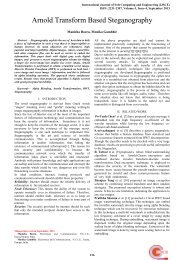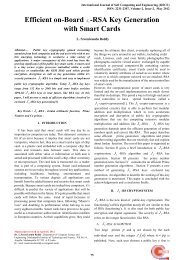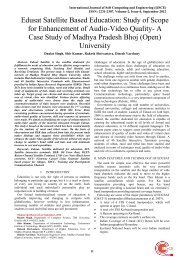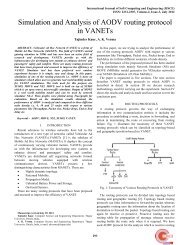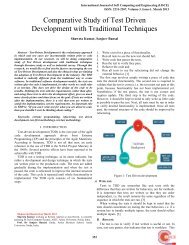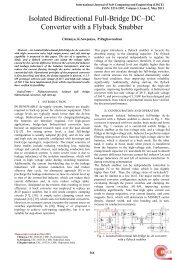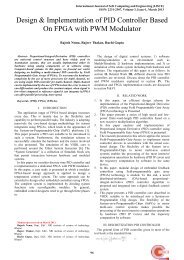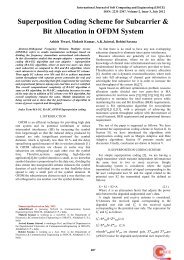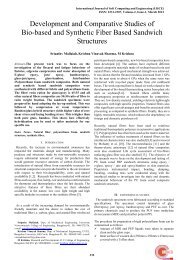Application of ICT in Crop Production - International Journal of Soft ...
Application of ICT in Crop Production - International Journal of Soft ...
Application of ICT in Crop Production - International Journal of Soft ...
You also want an ePaper? Increase the reach of your titles
YUMPU automatically turns print PDFs into web optimized ePapers that Google loves.
<strong>Application</strong> <strong>of</strong> <strong>ICT</strong> <strong>in</strong> <strong>Crop</strong> <strong>Production</strong><br />
development can stand [8]. At present, <strong>ICT</strong> is restricted to<br />
only the urban centres <strong>of</strong> the countries, yet statistics has it that<br />
about 70% <strong>of</strong> the citizens <strong>of</strong> develop<strong>in</strong>g countries are liv<strong>in</strong>g<br />
<strong>in</strong> rural areas.<br />
<strong>Application</strong> <strong>of</strong> <strong>ICT</strong> <strong>in</strong> crop production though a relatively<br />
new phenomenon, evidence <strong>of</strong> the contribution <strong>of</strong> <strong>ICT</strong> to<br />
agricultural development and poverty alleviation is becom<strong>in</strong>g<br />
<strong>in</strong>creas<strong>in</strong>gly obvious. [9] Some common problems <strong>in</strong><br />
adoption <strong>of</strong> <strong>ICT</strong> <strong>in</strong> rural segments such as <strong>ICT</strong> illiteracy,<br />
unavailability <strong>of</strong> relevant and localized contents <strong>in</strong> their own<br />
languages, uneasy and unaffordable accessibility and other<br />
issues like awareness and will<strong>in</strong>gness for adoption <strong>of</strong> new<br />
technologies among the rural peoples can def<strong>in</strong>itely be<br />
handled with the application <strong>of</strong> <strong>ICT</strong>. [10].<br />
Rural area is synonymous with agriculture because what<br />
affects rural development affects Agriculture. Thus for<br />
technology to have serious impact <strong>in</strong> develop<strong>in</strong>g countries, it<br />
must be made available to the rural area [11]. Information<br />
technology capabilities relate to the knowledge and skills<br />
required to effectively utilize communication equipment and<br />
correctly receive and transmit <strong>in</strong>formation up and down the<br />
channel <strong>of</strong> adm<strong>in</strong>istrative command [12]. The author also<br />
mentioned that IT capabilities consist <strong>of</strong> the resources needed<br />
to generate and manage <strong>in</strong>formation. <strong>ICT</strong> is also local<br />
<strong>in</strong>termediaries serv<strong>in</strong>g farmers who lack basic access to<br />
up-to-date <strong>in</strong>formation on best farm<strong>in</strong>g practices, market<br />
conditions, pest and disease control, weather forecasts, and a<br />
range <strong>of</strong> other issues [2].<br />
<strong>Application</strong> <strong>of</strong> <strong>ICT</strong> <strong>in</strong> Agriculture <strong>in</strong>volves focus<strong>in</strong>g on the<br />
enhancement <strong>of</strong> agricultural and rural development; this<br />
<strong>in</strong>volves application <strong>of</strong> <strong>in</strong>novative ways to use <strong>ICT</strong> <strong>in</strong> the<br />
rural doma<strong>in</strong>. The advancements <strong>in</strong> <strong>ICT</strong> can be utilized for<br />
provid<strong>in</strong>g accurate, timely, relevant <strong>in</strong>formation and services<br />
to the farmers, thereby facilitat<strong>in</strong>g an environment for more<br />
remunerative agriculture [10]. Taken <strong>in</strong>to account <strong>of</strong> the tides<br />
and trends that the research carried out <strong>in</strong> this area ended only<br />
<strong>in</strong> theory, therefore, this research will base on the design and<br />
implementation <strong>of</strong> an <strong>in</strong>formation system for crop production<br />
awareness to farmers.<br />
unless there is an improved version <strong>of</strong> the orig<strong>in</strong>al<br />
<strong>in</strong>formation.<br />
6. Verifiability: Farmer can also verify that the<br />
<strong>in</strong>formation they got is correct by go<strong>in</strong>g back to the site<br />
the second time or more.<br />
7. General: All farmers must be able to have access to the<br />
<strong>in</strong>formation system.<br />
B. Architecture <strong>of</strong> the Agro- Information System<br />
To accommodate the requirements presented <strong>in</strong> section 2.1<br />
above, architecture <strong>of</strong> the system was developed as shown <strong>in</strong><br />
fig.1.0 below. The system architecture def<strong>in</strong>es the key<br />
components <strong>of</strong> the proposed system together with the<br />
<strong>in</strong>teractions between these components. The system was<br />
modeled <strong>in</strong> a way that when a user want to view <strong>in</strong>formation<br />
<strong>in</strong> the system, the user has to enter a name <strong>of</strong> a particular<br />
crop, from there he selects the variety <strong>of</strong> the crop, and view<br />
the requirements <strong>of</strong> that variety. The developed system<br />
allows many farmers to use it simultaneously while ensur<strong>in</strong>g<br />
high availability any time the <strong>in</strong>formation is needed. For<br />
security purposes, update module can only be accessed by an<br />
Adm<strong>in</strong>istrator us<strong>in</strong>g an identity code. Below is architecture<br />
<strong>of</strong> the agro <strong>in</strong>formation system.<br />
III. THE AGRO-INFORMATION SYSTEM ANALYSIS<br />
This section shows a number <strong>of</strong> criteria that the design <strong>of</strong><br />
the system will satisfy. It also discussed the architecture <strong>of</strong><br />
the entire system and the data design.<br />
A. Requirements Def<strong>in</strong>ition for the Agro Information<br />
System<br />
The design <strong>of</strong> this system satisfies a number <strong>of</strong> sometimes<br />
compet<strong>in</strong>g criteria. These requirements are:<br />
1. Security: The <strong>in</strong>formation stored <strong>in</strong> the system cannot<br />
be tampered with unless by the adm<strong>in</strong>istrator when the<br />
need for update arises.<br />
2. Multi-user: A number <strong>of</strong> farmers can access the system<br />
simultaneously through the Internet.<br />
3. Accessibility: The system can be accessed by farmers<br />
from any location us<strong>in</strong>g secure <strong>in</strong>ternet and or mobile<br />
devices.<br />
4. Availability: The system is readily available to users<br />
through the Internet, mobile phones, and traditional<br />
media among others.<br />
5. Integrity/accuracy: Every <strong>in</strong>formation <strong>in</strong> the system<br />
comes from pr<strong>of</strong>essionals (those knowledgeable <strong>in</strong> field)<br />
and must have been tested and confirmed through<br />
scientific experiment. No alternation to this is permitted<br />
Fig. 1: The Architecture <strong>of</strong> the Agro-Information System<br />
C. Database<br />
Database has the core service for stor<strong>in</strong>g, process<strong>in</strong>g and<br />
secur<strong>in</strong>g data. The database server provides controlled access<br />
and rapid transaction process<strong>in</strong>g to meet the requirements <strong>of</strong><br />
the client tier. Information on all crop records, crop variety<br />
records and each crop variety requirements record resides <strong>in</strong><br />
this server as shown <strong>in</strong> Tables 1 and 2. The server is also<br />
responsible for authenticat<strong>in</strong>g adm<strong>in</strong>istrators authorization<br />
and the system when the need be. The relationships between<br />
the entities <strong>in</strong> the Tables mentioned above are also shown <strong>in</strong><br />
fig. 2.0.<br />
Table ia: All <strong>Crop</strong>s Tables<br />
Field name<br />
<strong>Crop</strong><br />
Botanical name<br />
Type<br />
<strong>Crop</strong> code<br />
Field type<br />
Text<br />
Text<br />
Text<br />
Text<br />
228



